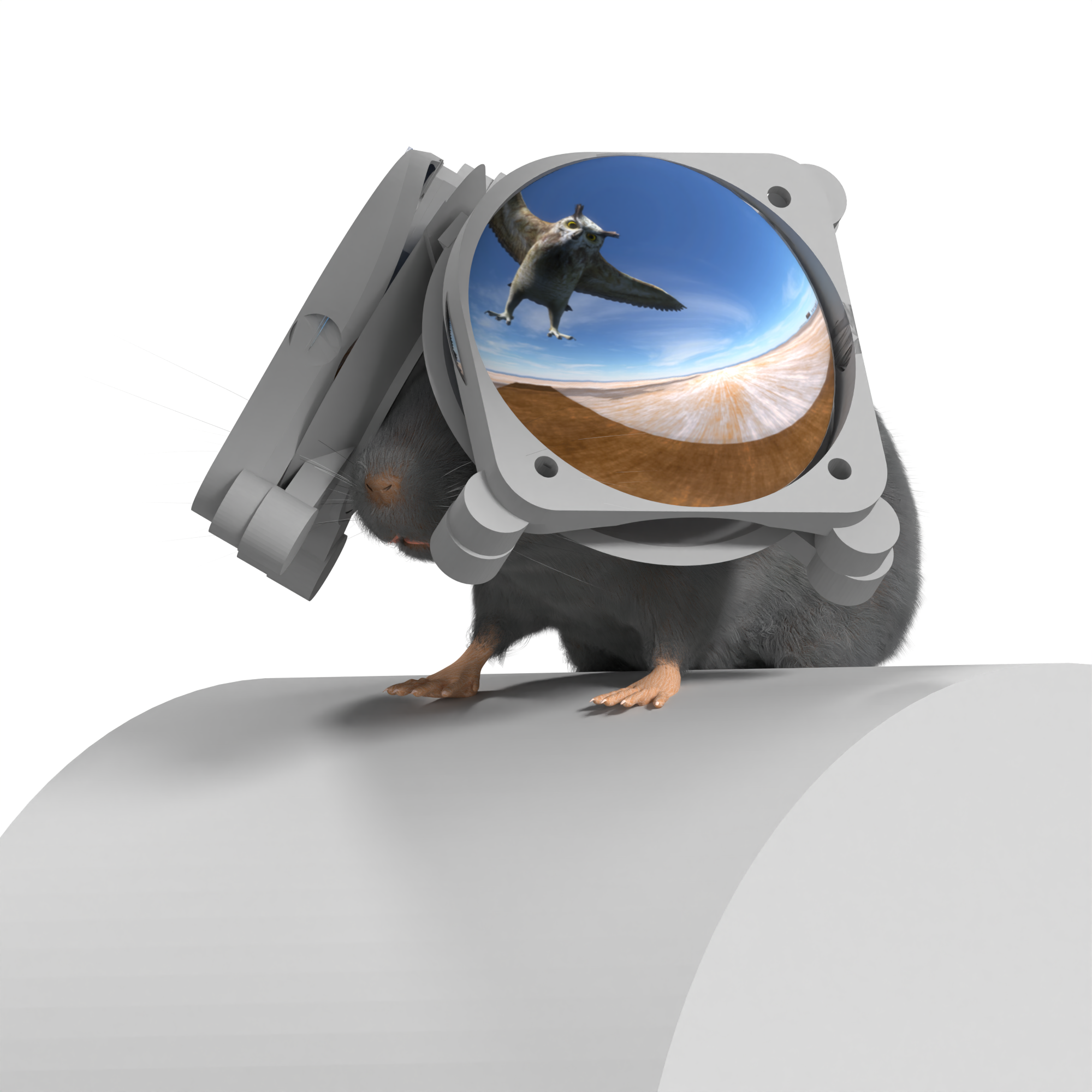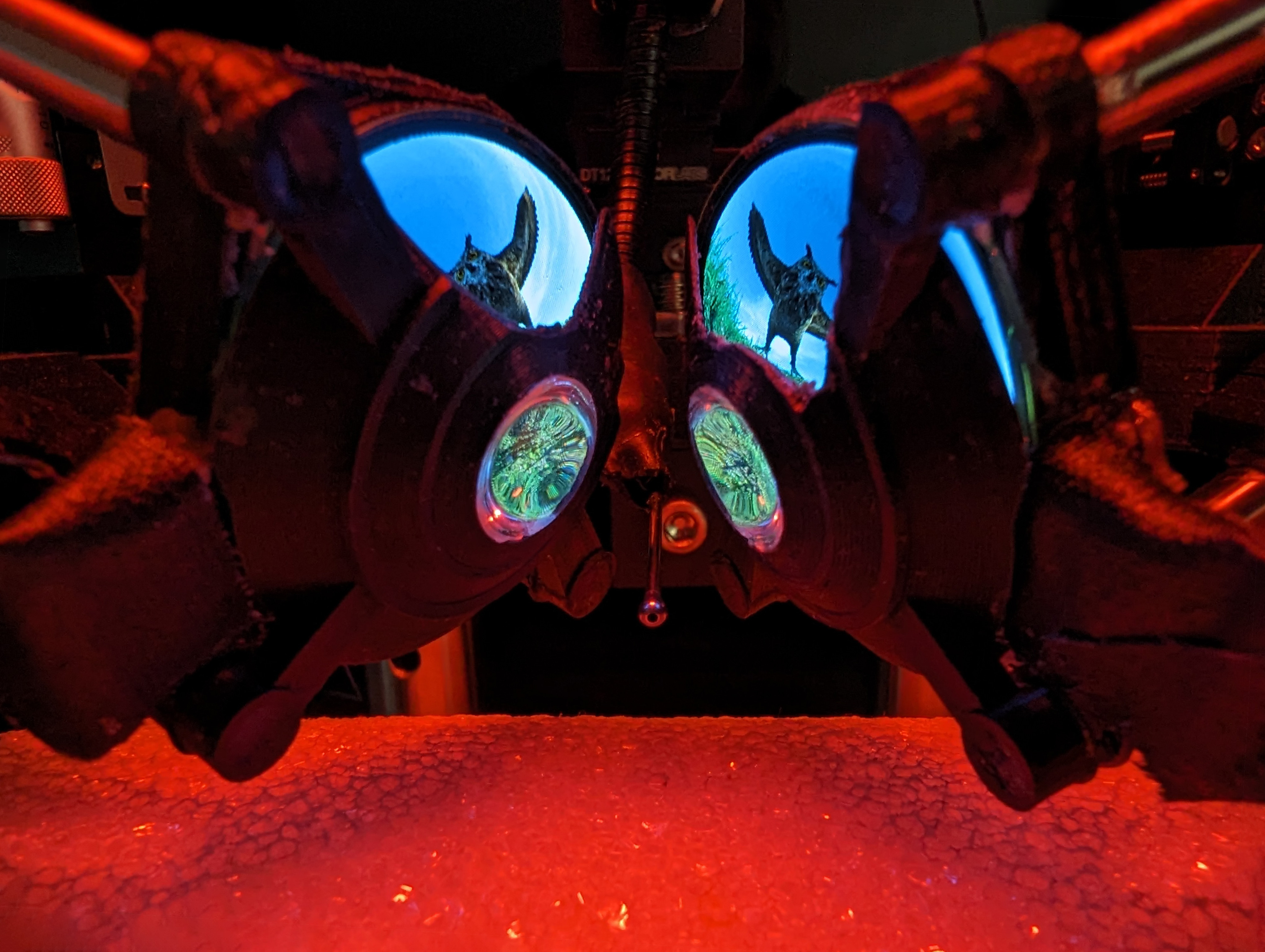Scientists have unveiled the new must-have accessory for the discerning lab mouse: virtual reality goggles.
Virtual reality (VR) has actually been a mainstay of neurobiological research for over a decade, but since they don’t make an Oculus Rift small enough for your average rodent, some compromise has been required. The current state-of-the-art systems use computer or projection screens to surround the mice with the researchers’ desired virtual environment, but there are a few problems with this approach. Now, a team at Northwestern University has solved all of these by developing a mouse-sized VR headset.

A 3D representation of the VR setup, with an airborne predatory bird projected into the top of the mouse’s visual field.
Image credit: Dom Pinke
The miniature goggles allow the mice to become fully immersed in a 3D VR scene, rather than the two dimensions offered by the computer screen approach. With the goggles, the scene fills the mouse’s entire field of vision, following them wherever they turn their heads.
This last aspect was tested out to its fullest extent by the team from Northwestern, as they used the goggles to simulate an attack from the skies.
“The top of a mouse’s field of view is very sensitive to detect predators from above, like a bird,” said co-first author Dom Pinke in a statement. “It’s not a learned behavior; it’s an imprinted behavior. It’s wired inside the mouse’s brain.”
To imitate this kind of threat, the researchers projected a dark disk at the top of the mice’s field of view in the goggles. The disk gradually expanded, and as the mice noticed it they responded in one of two ways: fleeing or freezing. These are both common reactions to predation events, but the setup allows the team to study this in great detail.
The mice are kept in place on a treadmill, so even while they are “running” through the virtual environment, the researchers can use brain mapping tools to look at the types of neural circuits that are being activated.

A mouse’s-eye view from inside the goggles.
Image credit: Dom Pinke
The custom VR system has been named Miniature Rodent Stereo Illumination VR (iMRSIV). Unlike human VR headsets, the goggles don’t actually wrap around the mouse’s head. Two sets of lenses and screens, one for each eye, are placed close to the animal’s face where it is located on the treadmill, providing a 180-degree visual field for each eye.
Although some fascinating insights have been obtained using more traditional VR systems, the mice can see around the screens, and this distraction makes training them more difficult. iMRSIV is a big step up.
“So far, labs have been using big computer or projection screens to surround an animal. For humans, this is like watching a TV in your living room. You still see your couch and your walls. There are cues around you, telling you that you aren’t inside the scene,” explained senior author Daniel Dombeck.
“We’ve had a lot of success with [the older] VR system, but it’s possible the animals aren’t as immersed as they would be in a real environment. It takes a lot of training just to get the mice to pay attention to the screens and ignore the lab around them.”
Now that iMRSIV is available, the team has high hopes that their innovation could help make VR research more accessible.
“We’re still working on improvements, but our goggles are small, relatively cheap and pretty user friendly as well. This could make VR technology more available to other labs,” said Dombeck.
As for where they envisage their own work going next, the experiment simulating a bird attack sparked some ideas.
“In the future, we’d like to look at situations where the mouse isn’t prey but is the predator,” said co-first author John Issa. “We could watch brain activity while it chases a fly, for example. That activity involves a lot of depth perception and estimating distances. Those are things that we can start to capture.”
The study is published in the journal Neuron.
Source Link: Miniature VR Goggles Made For Mice Open Up A New Frontier In Brain Research